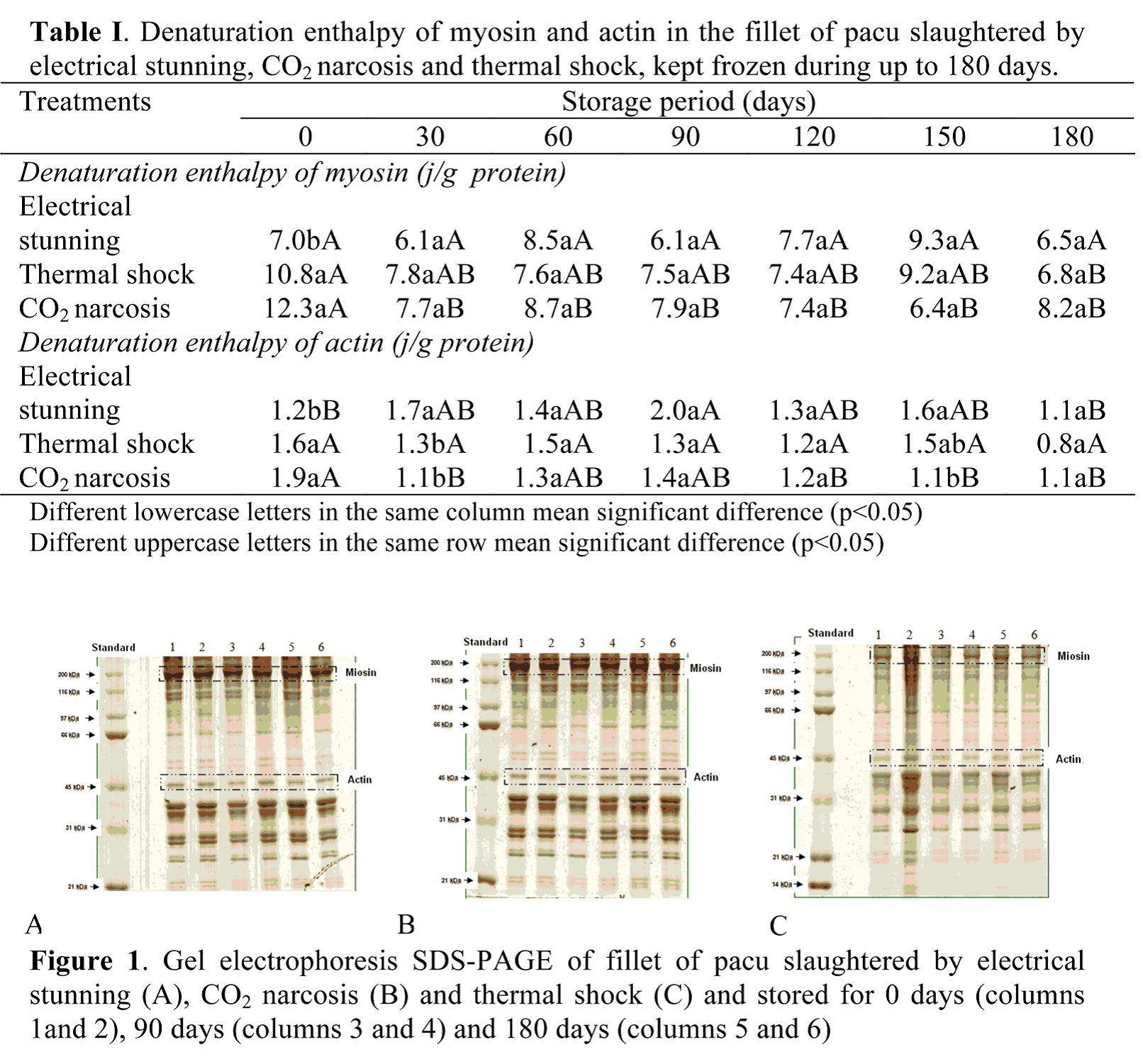Pacu is an omnivorous, freshwater fish typical of the wetlands located in South Mato Grosso, Brazil, which can also be found in the rivers of the Amazon and Prata basins. It is a species widely cultivated in Brazil due to its fast growth, hardiness and good acceptance by the consumers (MPA, 2010).
The freshwater fish cultivated in Brazil are most commonly stunned and slaughtered by thermal shock (1:1 water and ice); a method that is proven stressful since it does not kill immediately and can affect meat quality.
Due to pacu importance to Brazilian Aquaculture, it is necessary to determine the best slaughtering method in order to improve meat quality. The objective of this study is to evaluate how the usual methods used to slaughter pacu (electrical stunning, thermal shock and CO2 narcosis) influence protein denaturation of frozen fillets stored for 180 days.
Material and Methods
We used 126 pacus, Piaractus mesopotamicus, weighing an average 580 ± 113g. In the electrical stunning method, the fish underwent a continuous electric current (148V and 7A) at the same time for 3 minutes. In the CO2 narcosis, the fish were placed in a plastic box filled with 120L of water where CO2 gas was immediately injected until fish were completely stunned. In the thermal shock method, all the fish were submersed into a 60L water and 60L ice mixture at the same time.
After making sure the fish were dead, they were filleted, subsequently, underwent ultrafast freezing (-30ºC) and then, stored frozen (-18ºC) during up to 180 days. Protein denaturation was determined by differential scanning calorimetry (DSC) using the DSC-TA2010 model, according to Oliveira Filho et al. (2011). Frozen fillet samples were analyzed by polyacrylamide gel electrophoresis (SDS-PAGE) 15% as described by Laemmli (1970). Data were analyzed by ANOVA and means compared by Tukey test (P<0.05).

Results and Discussion
The methods used to slaughter pacu did not cause significant change in the denaturation temperature of myosin (53.3 ± 1.0°C) and actin (77.5± 0.3°C) proteins of the frozen fillets. These proteins remained stable during the 6-month frozen storage, indicating that the freezing method was adequate, and temperature fluctuations in the storage chamber (-18°C) did not destabilize the myofibrillar proteins.
The myosin denaturation, soon after slaughtering, at time zero, expressed by the enthalpy of denaturation was lower in fillets of pacu that underwent electrical stunning (Table I); however, it did not change over time. Likewise, actin denaturation soon after slaughtering was also lower in the fillets of the fish that underwent electrical stunning. On the other hand, after 30 and 150 days of storage, denaturation enthalpy was higher in the fillet of pacu that underwent electrical stunning compared
to either CO2 narcosis or thermal shock.
The electrophoresis did not show denaturation of myosin and actin proteins at the end of the 6 month storage in the fillet of pacu slaughtered by either electrical stunning or CO2 narcosis (Figures 1A, B). On the other hand, the fillet of fish slaughtered by thermal shock displayed myosin denaturation shown by gradual decreasing intensity of the electrophoresis band, which changed from 210.81±2.58kDa (0 days) to 177.61±2.32kDa (90 days) (Figure 1C).
Conclusion
The slaughtering methods by either electrical stunning or CO2 narcosis did not cause denaturation of the myofibrillar proteins, actin and myosin, during the storage (-18°C) of pacu fillet and, therefore, can be used as a slaughtering method for the species. Moreover, the commercial method (thermal shock, with ice water) caused denaturation of myofibrillar proteins and should be avoided in order to avoid compromising the quality of the fillets.
October 2013



